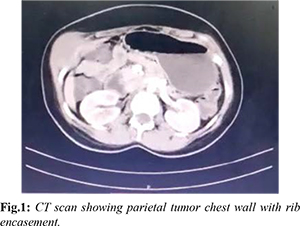6go6ckt5b8|3000F7576AC3|Tab_Articles|Fulltext|0xf1ffeca6370000008d06000001000300
6go6ckt5b5idvals|3120
6go6ckt5b5|2000F757Tab_Articles|Fulltext
Introduction
Chest wall tumors have long represented a unique challenge for surgeons. In the past, an inability to perform successful reconstruction for large thoracic wall defects led to high peri-operative morbidity due to pleural cavity infection, respiratory failure and paradoxical breathing [
1-
4]. The role of surgical treatment for primary malignant tumors is now established following improvement in surgical reconstruction, antibiotics prophylaxis and anaesthesia [
5].
Desmoid tumors (DT), a fibromatous proliferative disease, are defined by the World Health Organization as clonal fibroblastic proliferations that arise in the deep soft tissues and are characterized by infiltrative growth and a tendency toward local recurrence but an inability to metastasize [
6]. Although surgery is the primary treatment modality, there remains significant controversy amongst surgeons regarding the management of disease. We report a patient with a rare, significantly large desmoid tumor of the chest wall with bone encasement and diaphragmatic involvement to discuss the rarity, complexity of structure involvement and surgical challenge in view of rib encasement and diaphragmatic involvement.
Case Report
A 25-year-old lady presented with pain over right lower chest since last 2 years. Swelling over right lower chest extended upto upper abdomen. Clinical examination revealed a hard 5×4×4 cm swelling over right lower chest fixed to 7th, 8th and 9th rib moving with respiration. CT scan of abdomen and chest revealed heterogeneously enhancing soft tissue 6.4×4.5×5 cm lesion noted in anterior abdominal wall of right hypochondrium enclosing the 8th and 9th ribs [Fig.1].

Tru cut biopsy revealed spindle cell neoplasm having moderate differentiation spindly nuclei with bold chromatin. Intraoperatively there was a right chest tumor 6×8 cm over chest wall encircling 10th, 9th, and 8th rib abutting 11th and 7th extending to pleural cavity and diaphragm. Wide local excision and resection of diaphragm and rib and reconstruction of abdominal mesh plasty was done [Fig.2,3]. Patient had uneventful post-operative recovery. Histopathological evaluation and immunohistochemistry (IHC) revealed it as a case of desmoid type fibromatosis (5.5×5×3.4 cm) with the cells are focally positive for SMA, negative for CD34, S100, Desmin and CD117, Ki 67- 3-4% [Fig.4].
Discussion
Desmoid tumors arise from fascia and connective tissue of the muscular layers and invade surrounding structures. They are mainly seen in the abdominal region [
7]. Of the extra-abdominal sites, the chest wall is the most common [
8], whereas the other sites are the shoulder girdle and inguinal regions. There is also a close association with familial adenomatous polyposis and Gardner’s syndrome, suggesting the role of an intrinsic genetic defect in the development of desmoid tumors.
Treatment of these tumors involves wide local resections with stressing of the involved soft tissues and bony structures. Radiation therapy is usually used when a wide local excision cannot be accomplished. Chest wall tumors have long represented a unique challenge for surgeons and inability to perform successful reconstruction for large thoracic wall defects led to high peri-operative morbidity especially when it involves pleura and diaphragm. The advancement of surgical gadgets, modalities for surgical reconstruction, antibiotics prophylaxis and anaesthesia has now established the role of surgical treatment for primary malignant tumors.
Extra-abdominal desmoid tumors have a high local recurrence rate after resection [
9]. In a recent series of chest wall desmoid tumors, although the overall 5-year survival rate was 93%, the 5-year local recurrence rate despite aggressive surgical intervention was 29%. [
10], pointing to stress the importance of continued follow up in these patients even after attaining optimal wide tumor-free surgical resection margins, but these tumors rarely metastasise. This case was presented due to the complexity of the tumor, rarity of location and successful post-operative outcome of a rare complex presentation of desmoid tumors.
Conclusion
A rare large desmoid tumor of the chest wall is reported to discuss the complexity of structure involvement and surgical challenge in view of rib encasement and diaphragmatic involvement.
Contributors: SKK, RC, HKV: Surgeon and clinical care, and manuscript writing; SAS, GS: manuscript editing, patient management; HTN, AH: critical inputs into the manuscript and figures. RC will act as a study guarantor. All authors approved the final version of this manuscript and are responsible for all aspects of this study.
Funding: None; Competing interests: None stated.
References
- Lewis JJ, Boland PJ, Leuny DH, Woodruff JM, Brennan MF. The enigma of desmoid tumors. Ann Surg. 1999;299(6):866-872.
- Allen PJ, Shriver CD. Desmoid tumors of the chest wall. Semin Thorac Cardiovasc Surg. 1999;11(3):264-269.
- Dashiell TG, Payne WS, Hepper NGG, Soule EH. Desmoid tumors of the chest wall. Chest. 1978;74:157-162.
- Wilder F, D'Angelo S, Crago A. Soft tissue tumors of the trunk: Management of local disease in the breast and chest and abdominal walls. J Surg Oncol. 2015;111(5):546-552.
- Incarbone M, Pastorino, U. Surgical Treatment of chest wall tumors. WJ Surg. 2001;25(2):218-230.
- Shields CJ, Winter DC, Kirwan WO, Redmond HP. Desmoid tumors. Eur J Surg Oncol. 2001;27:701-706.
- McKinnon JG, Neifeld JP, Kay S, Parker GA, Foster WC, Lawrence W. Management of Desmoid tumors. Surg Gynecol Obstet. 1989;169:104-106.
- Kasper B, Strobel P, Hohenberger P. Desmoid tumors: Clinical features and treatment options for advanced disease. Oncologist. 2011;16(5):682-693.
- Weiss SW, Goldblum JR. Fibromatoses. In: Weiss SW, Goldblum JR, eds. Enzinger and Weiss’s soft tissue tumors, 4th ed. St. Louis, MO: Mosby, Inc., 2001:320-329.
- Brodsky JT, Gordon MS, Hajdu SI, Burt M. Desmoid tumors of the chest wall. A locally recurrent problem. J Thorac Cardiovasc Surg. 1992;104(4):900-903.